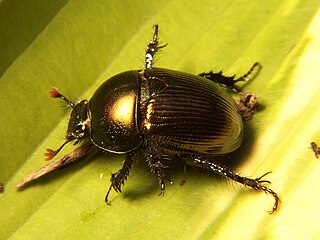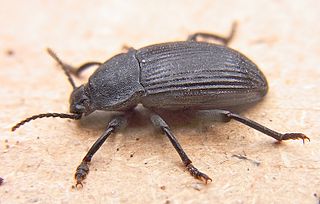
The family Scarabaeidae, as currently defined, consists of over 35,000 species of beetles worldwide; they are often called scarabs or scarab beetles. The classification of this family has undergone significant change in recent years. Several groups formerly treated as subfamilies have been elevated to family rank, and some reduced to lower ranks. The subfamilies listed in this article are in accordance with those in Catalog of Life (2023).

Stag beetles are a family of about 1,200 species of beetles in the family Lucanidae, currently classified in four subfamilies. Some species grow to over 12 centimetres, but most to about 5 cm (2 in).

Glaresis is a genus of beetles, sometimes called "Enigmatic scarab beetles", in its own family, the Glaresidae. It is closely related to, and was formerly included in, the family Scarabaeidae. Although its members occur in arid and sandy areas worldwide, only the nocturnal adults have ever been collected, and both the larvae and biology of Glaresis are as yet unknown. Due to their narrow habitat associations, a great number of these species occur in extremely limited geographic areas, and are accordingly imperiled by habitat destruction.

Trogidae, sometimes called hide beetles, is a family of beetles with a distinctive warty or bumpy appearance. Found worldwide, the family includes about 300 species contained in four or five genera.

Scarabaeoidea is a superfamily of beetles, the only subgroup of the infraorder Scarabaeiformia. Around 35,000 species are placed in this superfamily and some 200 new species are described each year. Its constituent families are also undergoing revision presently, and the family list below is only preliminary. This superfamily includes some of the largest beetles extant today, including rhinoceros beetles, (Dynastinae), the Hercules beetle and Goliath beetles.

Geotrupidae is a family of beetles in the order Coleoptera. They are commonly called earth-boring dung beetles or dor beetles. Most excavate burrows in which to lay their eggs. They are typically detritivores, provisioning their nests with leaf litter, but are occasionally coprophagous, similar to dung beetles. The eggs are laid in or upon the provision mass and buried, and the developing larvae feed upon the provisions. The burrows of some species can exceed 2 metres in depth.

Staphylinoidea is a superfamily of beetles. It is a very large and diverse group with worldwide distribution.

Aphodiinae is a subfamily of the scarab beetle family, Scarabaeidae. Members of this subfamily are known commonly as the small dung beetles and many, but not all, are dung beetles. These beetles are found worldwide.

Glaphyridae is a family of beetles, commonly known as bumble bee scarab beetles. There are eight extant genera with about 80 species distributed worldwide and two extinct genera described from the Aptian aged Yixian Formation of China. There are cases of flower-beetle interactions, in the southeast Mediterranean region between red bowl-shaped flowers and Glaphyridae beetles.

Aclopinae is a subfamily of Scarabaeidae or scarab beetles in the superfamily Scarabaeoidea.
The Amblyseiinae are a subfamily of mites in the Phytoseiidae family.

Eupatorus gracilicornis, the five-horned rhinoceros beetle is a beetle that has four large horns on the prothorax and one extra-long cephalic horn. Rhinoceros beetles, the Dynastinae, are a subfamily of the scarab beetle family (Scarabaeidae).

The Aleocharinae are one of the largest subfamilies of rove beetles, containing over 12,000 species. Previously subject to large-scale debate whether the subfamily deserved the familial status, it is now considered one of the largest subfamilies of rove beetles.

Coccinellinae is a subfamily of lady beetles in the family Coccinellidae. There are at least 20 genera and 90 described species in Coccinellinae.

Geotrupinae is a subfamily of earth-boring scarab beetles in the family Geotrupidae. There are more than 30 genera and 450 described species in Geotrupinae.

Psammodiini is a tribe of aphodiine dung beetles in the family Scarabaeidae. There are more than 30 genera and 470 described species in Psammodiini.

Macremphytus is a genus of common sawflies in the family Tenthredinidae. There are at least four described species in Macremphytus.

Dendarini is a tribe of darkling beetles in the family Tenebrionidae. There are more than 30 genera in Dendarini.

















